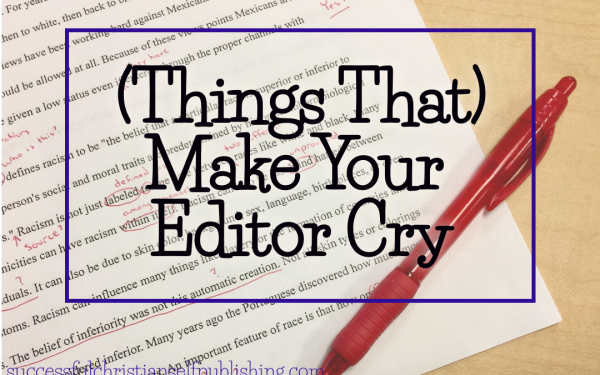Dear Weeping Editor: Touch

Dear Weeping Editor,
I went to a writers’ conference a few years back and the repeating theme was never to use the word “feel” in my novel. The constant advice was to “show instead of tell.” I guess “feel” is telling?
How can I describe the sense of touch without describing how something feels?
I look forward to your advice.
Signed,
Feeling out of Touch
Dear Feeling,
What a great question! I feel so honored (see what I did there?) you would ask for my opinion.
Okay, so let’s get something straight right off the bat. Attending a writers’ conference should be mandatory. There is so much to learn, not to mention the networking and fellowship opportunities they provide. I believe that finding yourself in a room chock full of people just as quirky and nutty as you are is an essential experience for authors.
That said, some of the advice you get at a writers’ conference is subject to change over time. Trust me on this. I have taught at a lot of them literally all over the world. What happens sometimes is you attend sessions that share information on the latest trends in the industry or what’s really popular and selling at the moment. A while back, the big push was to eliminate all the dialogue tags. The following year was a pretty rough one for me as an editor, and I can’t imagine I’m alone in that. I’m saying some of that advice turns out to be a little bit, well, faddish. Seen any sparkling vampires lately?
As with all things, with the things you learn at a conference, you have to swallow the meat and spit out the bones.
Now, the specific bit of advice you mention—to avoid using the word “feel”— is an enduring old saw. I remember hearing that exact advice handed down myself at both secular and Christian conferences. It’s actually valid advice, but only in context.
The problem is that there is a lot of immature writing along the lines of, “She felt sad. It made him feel angry. This made her feel confused. This made him feel even angrier.” I think we can all agree no one wants to read something like that. And I think it is pretty clear that these sentences are all textbook examples of telling not showing.
The confusion, I think, arises between emotional feelings like in those awful sentences above and the physical sense of touch aspect of feeling, as in feeling something with some part of your body.
Emotional feelings run the gamut from happy to sad, overwhelmed to anxious, desperate to contented. I think we all know what this means and understand how our characters feel at an emotional level.
Physical feelings are things like how the soup felt warm as you swallowed, or how the homespun felt coarse against your skin, or how her hand felt fragile in your strong grip. I think we all know what this means, too.
Readers want to experience all seven senses along with your characters. What your characters smell, taste, hear, see, touch, and any variances in their proprioception sense or vestibular sense should transport the reader into the character’s experience. Good writers include these sensory details in ways that actively envelop the reader, not in ways that pull the reader out of the story.
The advice to avoid the word “feel” and to “show don’t tell” mainly applies to emotional feelings, not physical touch.
Instead of “telling” the reader that “she knew he must feel angry” or “she suddenly felt happy” good writers know to “show” those emotions.
Incorrect:
She knew he must feel angry.
She suddenly felt happy.
Correct:
She watched as his eyes darkened, his nostrils flared, and the muscles in his jaw tightened.
An unfamiliar ache in her cheeks informed her that a delighted smile had taken over her expression.
However, when it comes to physical touch, I think it is just fine to use “feel” or its forms to describe the sensation. I mean, you probably want to change it up from time to time.
Examples:
She felt the silky fabric, letting the downy sensation tickle her fingertips.
She touched the silky fabric, letting the downy sensation tickle her fingertips.
She let her fingertips trace the silky fabric, taking in the almost ticklish downy sensation.
There are not a lot of ways to say you are physically feeling something that won’t trip up the reader, or pull her clean out of the story. Your sentence should do two things. First of all, it should exist. You should never ignore the sense of touch. Secondly, it should read naturally and communicate the point without reading too bluntly.
Here is a little trick you can use when crafting a first draft (not a final draft). Whenever you mean to describe physical feeling, actually use the word touch. Whenever you mean emotional feelings, try not to use the word feel. You might end up never using the word “feel” at all in your first draft that way. And I think that is what those folks at the writers’ conferences were trying to explain.
Examples (relevant text not in italics):
Incorrect:
She saw the orange flames. She heard the sirens. She felt the soaking leaves of the tall magnolia in the front yard. She felt confused and frozen.
Correct:
She saw the orange flames. She heard the sirens. She touched the soaking leaves of the tall magnolia in the front yard. Confusion gripped her and froze her in place.
In the second to last sentence, the word touch absolutely clarifies that we are contending with the physical sense of touch. The word touch is also a little bit more specific than the word feel in this context. Again, I don’t recommend using this trick all the time. In the final draft if some form of “feel” reads better, sounds better when you read it aloud, or fits more naturally in the flow of the narrative, then go ahead and use “feel” instead.
In the last sentence, the correct example “shows” how emotions affected her, instead of “telling” the reader about the emotions she experienced. By relating her emotions more actively, we form a more engaging sentence for the reader.
The important aspects of physical touch are the temperature and the texture in that order. You can physically feel cold, warm, or hot without being in physical contact with a texture, so temperature is something you should always, always describe. Whenever your character physically comes into contact with something (or someone), you want to describe texture.
Texture can describe the way something looks, but that is not what I am talking about. It also describes the way something feels when touched or eaten, or the way it feels because of the way it was made. That’s what I’m talking about. You need to describe the texture of something (or someone) your character touches.
Again, thanks for the question. I hope I have done the answer justice and you feel better now (did it again!).
Here are two lists of words to help you explore ways to describe temperature or texture.
Temperature
For temperature, there are only so many English words that describe the range. Here are some to get you going.
arctic, ardent, benumbed, bitter, bitter cold, bitter hot, blazing, bleak, blizzardly, boiling, bone-chilling, broiling, burning, chill, chilled, chilly, cold, coldish, cool, cooled, coolish, feverish, fiery, flushed, freezing, frigid, frosted, frosty, frozen, glacial, glowing, heated, hot, hottish, ice-cold, iced, icy, igneous, lukewarm, molten, nipped, nippy, numbing, overheated, piping hot, polar, raw, red, red-hot, refrigerated, reheated, rewarmed, roasted, roasting, scalding, scorching, searing, seething, sharp, shivery, sizzling, snappy, snowy, snug, steamy, subfreezing, subzero, sultry, summery, superheated, sweltering, tepid, thawed, toasty, torrid, tropical, ultracold, ultrahot, unheated, warm, warmed, warmed-over, warmish, white-hot, winterly, wintry
Texture
Abrasive, Ample, Angular, Bald, Barbed, Bendable, Blemished, Blistered, Bloated, Blunt, Bristly, Broken, Bubbly, Bulging, Bulky, Bumpy, Bushy, Caked, Carved, Chafing, Chapped, Chunky, Circular, Clammy, Clean, Coarse, Cold, Cool, Corrugated, Cratered, Crenelated, Crocheted, Cushioned, Damaged, Damp, Dehydrated, Dense, Dented, Dirty, Distended, Distorted, Doughy, Downy, Drenched, Dry, Dusty,, Embossed, Enameled, Encrusted, Engorged, Engraved, Etched, Even, Fat, Feathery, Filmy, Firm, Flat, Fleecy, Flimsy, Fluffy, Fluted, Fragile, Freezing, Frigid, Frothy, Furry, Fuzzy,, Gelatinous, Glassy, Glazed, Glossy, Glutinous, Gnarled, Gooey, Gossamer, Grainy, Granular, Grating, Gravelly, Greasy, Grimy, Gritty, Grooved, Grubby, Hairy, Hard, Harsh, Hollow, Hot, Icy, Impenetrable, Imprinted, Indented, Inflated, Inlaid, Inscribed, Ironed, Irregular, Itchy, Jagged, Knitted, Layered, Leathery, Level, Limp, Lined, Long-haired, Loose, Luke-warm, Lumpy, Malleable, Metallic, Moist, Mosaic, Mushy, Narrow, Neat, Oily, Ornamented, Padded, Patterned, Pleated, Pliable, Pockmarked, Pointed, Pointy, Polished, Pot-holed, Prickly, Printed, Pulpy, Ragged, Rasping, Razor-sharp, Refined, Ribbed, Ridged, Rigid, Rough, Rubbery, Rusty, Rutted, Sandy, Saturated, Scalding, Scarred, Scored, Scraped, Scratched, Sculptured, Serrated, Shaggy, Sharp-edged, Sheer, Silky, Slick, Slimy, Slippery, Smooth, Soaked, Soapy, Sodden, Soft, Soggy, Soiled, Solid, Sopping, Spiky, Spiny, Spongy, Springy, Steely, Stiff, Sticky, Stubbly, Stuccoed, Sweaty, Swollen, Syrupy, Thick, Thin, Thorny, Throbbing, Tiled, Tough, Tweedy, Unblemished, Unbreakable, Uncomfortable, Uneven, Unyielding, Varnished, Velvety, Veneered, Vibrating, Viscous, Warm, Waterlogged, Wavy, Wet, Wide, Wiry, Withered, Woolen, Woven, Wrinkled, Yielding, Zigzag

Gregg Bridgeman is the Editor-in-Chief at Olivia Kimbrell Press. He is husband to best-selling Christian author Hallee Bridgeman and parent to three. He continues to proudly serve in the US Armed Forces and has done so in either an active or reserve capacity for more than twenty years as an airborne and air assault qualified paratrooper, earning a Bronze Star for his service. Most importantly, he was ordained in October of 2001 after surrendering his life to Christ decades earlier.

